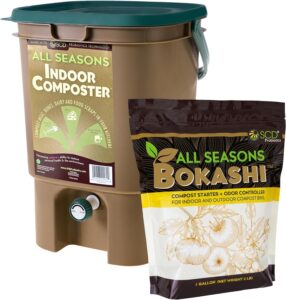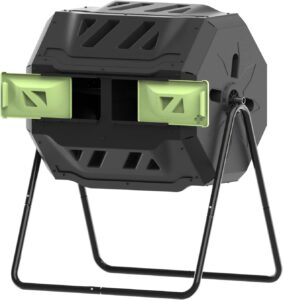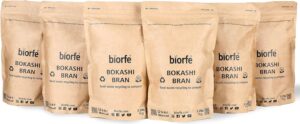Introduction
As an enthusiastic gardener and eco-conscious individual, I have delved into the world of composting with great excitement and passion. Composting is not only a practical way to reduce waste but also a remarkable method to nurture the environment, improve soil health, and grow thriving plants. In this comprehensive guide, we’ll cover composting 101, and I will walk you through the fundamentals, benefits, techniques, and practical tips to help you embark on your own composting journey.
What is Composting?
Composting 101, at its very basics, is a natural process of decomposition that converts organic materials into nutrient-rich humus. It involves the breakdown of various organic materials, such as kitchen scraps, yard waste, leaves, and plant residues, through the actions of microorganisms, including bacteria, fungi, and insects. These microorganisms transform the organic matter into a dark, crumbly substance called compost, which is highly beneficial for enriching soil and supporting plant growth.
Benefits of Composting
Composting offers a multitude of advantages, ranging from environmental benefits to the improvement of soil quality. Let’s explore some of the key benefits:
Environmental Benefits
Composting plays a vital role in waste management and environmental sustainability. By diverting organic materials from landfills, composting reduces the production of greenhouse gases, such as methane, which contribute to climate change. It helps minimize the burden on landfill space, allowing for more efficient waste management.
Improving Soil Quality
Compost is a treasure trove of nutrients that can transform depleted soil into a thriving ecosystem. Compost enhances soil structure, improves water retention, and promotes beneficial microbial activity when added to garden beds or used as a topdressing. It replenishes essential nutrients, such as nitrogen, phosphorus, and potassium, which are vital for healthy plant growth.
Reducing Waste and Landfill Contributions
Composting allows us to close the loop in the cycle of organic matter. Instead of discarding kitchen scraps, yard trimmings, and other organic waste, we can transform them into a valuable resource; and composting toilets take this one step further! By composting, we reduce the amount of waste sent to landfills, minimize the generation of greenhouse gases from decomposing organic materials, and contribute to a more sustainable future.
Composting 101: Getting Started
Now that we understand the significance of composting let’s explore how you can start with Composting 101.
Composting 101 First step: Assessing Your Composting Needs and Goals
Composting 101 starts with assessing your specific needs and goals. Consider the amount of organic waste you generate, the space available for composting, and the level of involvement you desire. This evaluation will help you determine the most suitable composting method and scale for your circumstances.
Identifying Available Resources and Space
Next, consider the resources and space you have at your disposal. Composting can be done on various scales, ranging from small-scale systems for apartment dwellers to larger compost piles or bins for those with more outdoor space. Evaluate the availability of raw materials, such as kitchen scraps and yard waste, as well as the space where you can establish your composting setup.
Choosing a Composting Method
Composting methods vary depending on factors such as available space, time commitment, and desired outcomes. Let’s explore some popular composting methods to help you choose the one that suits your needs best.
Traditional Backyard Composting
The traditional backyard composting method is a time-tested approach for many home gardeners. It involves creating a compost pile or using a compost bin in your yard to decompose organic materials naturally. This method is well-suited for those with sufficient outdoor space and a desire for a more hands-on composting experience.
Vermicomposting (Worm Composting)
Vermicomposting, or worm composting, is an ideal solution for individuals with limited space or those living in apartments. It utilizes special composting worms, such as red wigglers, to break down organic materials. Worm bins can be kept indoors or in a small outdoor space, making it a convenient option for urban dwellers.
Bokashi Composting
Bokashi composting is a unique method that employs fermentation to break down organic waste. It involves using a special bokashi bran, typically composed of beneficial microorganisms, to accelerate the decomposition process. Bokashi composting is well-suited for individuals who prefer a fast and odor-free composting experience and can be done indoors or outdoors.
Compost Tumblers
Compost tumblers are rotating containers that facilitate the decomposition process by providing aeration and mixing. They offer a more controlled and efficient composting experience compared to traditional compost piles. Compost tumblers are suitable for those who desire a faster composting process and have limited space or specific aesthetic preferences.
Selecting the Right Composting Materials
To achieve successful composting, it’s essential to have the right mix of organic materials. The key to a thriving compost pile lies in achieving a balance between carbon-rich (brown) and nitrogen-rich (green) materials.
Green Materials (Nitrogen-rich)
Green materials include kitchen scraps, such as fruit and vegetable peels, coffee grounds, tea leaves, and fresh grass clippings. These materials are nitrogen-rich and provide a source of protein for the microorganisms involved in decomposition.
Brown Materials (Carbon-rich)
Brown materials consist of dry leaves, straw, shredded newspaper, cardboard, and woody plant trimmings. These carbon-rich materials provide energy for the microorganisms and help create an optimal carbon-to-nitrogen balance in the compost pile.
Achieving the right balance between green and brown materials is crucial. A general rule of thumb is to aim for a ratio of approximately three parts brown materials to one part green materials. This balance provides an ideal environment for microorganisms to thrive and ensures efficient decomposition.
Setting Up Your Compost Bin
Once you’ve selected a composting method and gathered the necessary materials, it’s time to set up your compost bin. The type of bin you choose will depend on your chosen composting method and the space available.
Traditional Compost Piles or Bins
For traditional composting or larger-scale operations, a compost pile or bin can be created using a variety of materials, such as wire mesh, wooden pallets, or cinder blocks. Ensure that the bin has adequate airflow and drainage to facilitate the composting process.
Worm Bins for Vermicomposting
Vermicomposting requires a specially designed worm bin that provides a suitable habitat for composting worms. These bins can be purchased or easily constructed using plastic storage containers or wooden boxes. The bin should have adequate ventilation and moisture control to ensure the worms’ well-being and promote effective decomposition.
Bokashi Bins for Bokashi Composting
Bokashi composting typically utilizes airtight containers or buckets to facilitate the fermentation process. These containers should be equipped with a tight-fitting lid to create an anaerobic environment necessary for the breakdown of organic waste through fermentation. It’s important to follow the instructions provided with your bokashi composting system for best results.
Maintaining Your Compost
Composting 101 involves proper maintenance is crucial. Regular monitoring and a few essential tasks will keep your compost pile healthy and active.
Proper Moisture Levels
Maintaining the right moisture levels in your compost pile is essential for decomposition. The compost should have a damp, sponge-like consistency. If it becomes too dry, add water while ensuring not to make it overly soggy. Conversely, if the compost is too wet, mix in additional dry materials like shredded newspaper or dry leaves to absorb excess moisture.
Turning and Aerating the Compost
Turning or aerating the compost helps introduce oxygen into the pile, which is necessary for the decomposition process. Every few weeks, use a pitchfork or compost-turning tool to mix the materials thoroughly. This allows for an even distribution of moisture, promotes microbial activity, and accelerates decomposition.
Monitoring Temperature and Decomposition Progress
Regularly monitoring the temperature of your compost pile provides insights into its progress. During decomposition, microorganisms generate heat, resulting in an increase in temperature. Ideally, the internal temperature of the compost should be between 130°F (54°C) and 160°F (71°C). This temperature range ensures the destruction of pathogens and weed seeds while promoting efficient decomposition. Use a compost thermometer to measure the temperature at various depths within the pile.
Troubleshooting Common Composting Issues
While composting is a relatively simple process, occasional challenges may arise. An article on Composting 101 wouldn’t be complete without addressing some common issues and providing solutions to overcome them.
Odor Problems
Unpleasant odors emanating from your compost pile can indicate an imbalance or inadequate aeration. To mitigate odors, ensure a proper balance between green and brown materials. Avoid adding meat, dairy products, or oily items to your compost, as these can contribute to odor issues. Additionally, regular turning and aerating of the composting pile will introduce oxygen and help manage odors effectively.
Pests and Rodents
While composting is generally a pest-resistant process, certain precautions can be taken to deter pests and rodents. Bury food scraps under a layer of brown materials to discourage pests from accessing the compost. Consider using a secure compost bin or adding a layer of wire mesh to prevent larger critters from gaining access. Avoid composting meat, fish, or dairy products, as these may attract unwanted pests.
Slow Decomposition
If your compost pile is decomposing slowly, several factors may be contributing to the issue. Ensure that you have a proper balance of green and brown materials. Adjust the moisture levels if necessary, aiming for a damp but not overly wet compost. Consider turning the compost more frequently to improve aeration and increase microbial activity. If the materials are too large or dense, break them down into smaller pieces to facilitate decomposition.
Using Compost in Your Garden
Once your compost has reached the desired state, it’s time to reap the rewards and utilize it in your garden. Compost is a valuable organic fertilizer and soil amendment that can bring numerous benefits to your plants.
Benefits of Using Compost in Gardening
Using compost in your garden offers a plethora of advantages. It improves soil fertility and structure, enhances water retention, and promotes the growth of beneficial soil microorganisms. Compost releases nutrients slowly over time, providing a steady supply of essential elements for plant growth. By incorporating compost into your garden beds, you create an environment that supports robust plant development and resilience.
Incorporating Compost into Soil
To maximize the benefits of compost, incorporate it into the soil before planting. Spread a layer of compost evenly over the garden bed and mix it thoroughly into the top few inches of soil. This ensures that the compost and existing soil blend together, providing a nutrient-rich foundation for your plants.
Topdressing and Side-Dressing with Compost
For established plants, topdressing and side-dressing with compost can provide ongoing nourishment. Topdressing involves applying a thin layer of compost around the base of plants, covering the root zone. This helps retain moisture, suppress weeds, and gradually release nutrients. Side-dressing entails placing compost alongside growing plants to provide additional nutrients during the growing season. Gently work the compost into the soil surface around the plants, taking care not to disturb the roots. Of course, if you’re talking about an expansive area, it might be worth looking at a compost spreader.
Composting 101 Dos and Don’ts
To ensure a successful and hassle-free composting experience, it’s important to follow certain guidelines and avoid common pitfalls. Let’s review some dos and don’ts of composting:
Dos
- Do add a variety of organic materials to your composting pile, including fruit and vegetable scraps, coffee grounds, tea leaves, eggshells, yard trimmings, and shredded paper. A diverse mix of materials provides a broader range of nutrients and helps maintain a balanced compost pile.
- Do turn your compost pile regularly to promote aeration and accelerate decomposition. Aim to turn the pile every few weeks, mixing the materials thoroughly to ensure even breakdown.
- Do maintain the right moisture levels by watering your compost pile as needed. The compost should be moist but not overly wet or waterlogged.
- Do be patient with the composting process. It takes time for organic materials to decompose fully and transform into rich, dark compost. Regular maintenance and proper conditions will expedite the process, but expect it to take several months to a year to achieve usable compost.
Don’ts
- Don’t add meat, fish, dairy products, or oily foods to your compost. These materials can attract pests, contribute to unpleasant odors, and disrupt the balance of your compost pile.
- Don’t add weeds that have gone to seed or plants infected with diseases to your compost. The high temperatures reached during composting may not kill weed seeds or pathogens, resulting in potential weed or disease issues when using the compost.
Composting 101 for Apartment Dwellers
Living in an apartment doesn’t mean you can’t enjoy the benefits of composting. Here are some methods suitable for apartment dwellers:
Indoor Composting Options
For those with limited space, indoor composting methods provide a convenient solution. Vermicomposting, or worm composting, can be done indoors using specially designed worm bins. These compact systems house composting worms that thrive on kitchen scraps and produce nutrient-rich castings. Indoor composting bins or bokashi composting systems that utilize fermentation are also viable options for apartment dwellers.
Managing Compost in Limited Spaces
To maximize space utilization, consider utilizing compact compost bins or composting bags. These containers can fit on balconies, patios, or even kitchen countertops. They provide a contained environment for composting while minimizing the footprint in small living spaces. These systems often employ efficient decomposition methods, such as bokashi composting or composting with specialized microbial inoculants, to break down organic waste quickly and effectively.
Composting in Cold Climates
Cold climates present unique challenges for composting due to lower temperatures and reduced microbial activity. However, with a few adjustments, composting can still be successful even in colder regions.
Strategies for Composting in Cold Climates
Insulation is key when composting in cold climates. Consider insulating your compost bin with materials such as straw, hay, or bubble wrap to help retain heat. Covering the compost pile with a tarp or utilizing specialized insulated compost bins can also help maintain higher temperatures. Chopping materials into smaller pieces can increase surface area and aid in decomposition. Additionally, using a higher proportion of green materials in the compost mix can provide more nitrogen and help generate heat.
Winter Composting Tips
During the winter months, when microbial activity slows down, it’s important to adjust your composting practices. Start by stockpiling brown materials, such as dry leaves, straw, or wood chips, in the fall to ensure a ready supply throughout the winter. Continue adding kitchen scraps and other green materials, but in smaller quantities. Insulate the compost pile or bin adequately to maintain a higher internal temperature. Avoid turning the compost pile frequently during extremely cold periods, as it can disrupt the heat retention.
Composting for Busy Individuals
Even if you lead a busy lifestyle, you can still incorporate composting into your routine. Consider these time-saving composting practices:
Low-Maintenance Composting Methods
Certain composting methods require minimal effort and attention, making them ideal for busy individuals. Bokashi composting, for example, involves fermenting organic waste in airtight containers, which requires minimal maintenance and can be done at your convenience. Compost tumblers are another option that simplifies the composting process, as they provide a controlled environment for decomposition and require less frequent turning or maintenance.
Time-Saving Composting Practices
To streamline the composting process, adopt time-saving practices. Chop larger materials, such as branches or plant stalks, into smaller pieces before adding them to the compost pile. This will expedite decomposition. Consider using a shredder or lawnmower to break down leaves and other bulky materials quickly. Utilize a compost pail or container in your kitchen to collect food scraps conveniently, reducing the need for frequent trips to the outdoor compost bin.
Conclusion
Composting is a transformative practice that benefits both the environment and our gardens. By diverting organic waste from landfills and harnessing the power of decomposition, we can create nutrient-rich compost that nourishes the soil, supports plant growth, and promotes sustainability. Whether you have a backyard or live in an apartment, there’s a composting method suited to your needs and space. Embrace the journey of composting and contribute to a greener future, starting with composting 101.
FAQs
Can I compost citrus peels and onion skins?
Yes, citrus peels and onion skins can be composted. However, it’s best to chop them into smaller pieces to speed up the decomposition process.
How long does it take for compost to be ready to use?
The time it takes for compost to fully decompose can vary depending on various factors such as temperature, moisture, and the materials used. On average, it can take anywhere from a few months to a year.
Can I compost pet waste?
It’s generally not recommended to compost pet waste, especially from carnivorous animals. Pet waste can contain pathogens that may survive the composting process and pose a risk to human health.
What can I do with finished compost if I don’t have a garden?
Finished compost can be donated to community gardens, local farms, or used as a soil amendment in landscaping projects.
Can I compost weeds?
You can compost weeds, but it’s important to ensure that they have not gone to seed. High-temperature composting can kill weed seeds, preventing them from sprouting in your garden.





Pingback: Composting Worms: The Unsung Heroes of Your Garden - Eco Life Wise
Pingback: Bokashi Composting: Green Thumbs, Unite! - Eco Life Wise
Pingback: Benefits of Composting: A Complete Guide - Eco Life Wise
Pingback: Eco Friendly Phone Cases: Smart For a Sustainable Lifestyle - Eco Life Wise
Pingback: How to Make Compost: A Guide to a Greener Garden
Pingback: Sustainable Agriculture: A Green Revolution - Eco Life Wise
Pingback: Composting Toilets: From Waste to Wonder and Fertilizer Gold! - Eco Life Wise
Pingback: Compost Spreader: You and Your Garden's Best Friend - Eco Life Wise
Pingback: DIY Compost Bin: Master the Art of Composting in Your Backyard | Eco Life Wise
Pingback: Eco Friendly Toilet Paper: A Cheeky Guide to Going Green